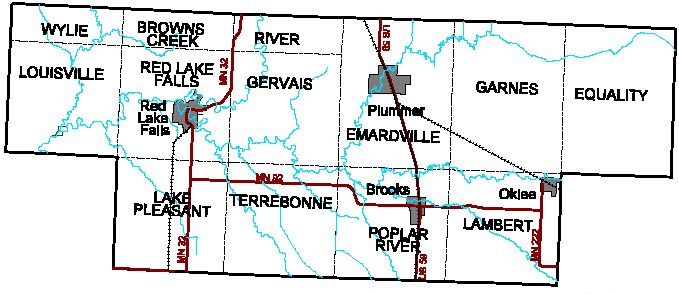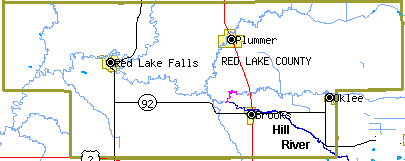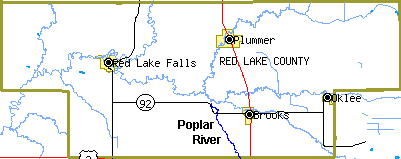|
|
[Towns] [Rivers and Streams]
Established December 24, 1896, this county received its name from the Red Lake River, which flows through it, giving also its name to Red Lake Falls, the county seat. The river derives its name, in turn, from Red Lake, these both being translations of their Ojibway names.

Why these Indians originally so designated the lake was uncertain until it was ascertained by the late Rev. Joseph A. Gilfillan. It had been affirmed, with poetic license, by Beltrami, who traveled here in 1823, publishing in 1824 and 1828, that the aboriginal names of Red Lake and its outflowing river, the latter translated by him Bloody river, refer to the "blood of the slain," in the wars between the Ojibways and Dakotas. Gilfillan, who was a missionary to the Ojibways of northwestern Minnesota from 1873 to 1898, wrote in 1885 that the Ojibway name of this lake, written by him "Misquagumiwi sagaiigun, Red-water lake," perhaps alludes to "reddish fine gravel or sand along the shore in places, which in storms gets wrought into the water near the edges," or to the reddish color of streams flowing into the lake from bogs on its north side, probably reddened by bog iron ore. He later wrote, however, in a letter of February, 1899, that these are erroneous conjectures of some of the Ojibways, and that he had obtained more reliable information, so that he could then confidently state the origin of this name, as follows: "Red Lake is so called from the color of the lake [reflecting the redness of sunset] on a calm summer evening, when unruffled by wind and in a glassy state, at which times it is of a distinctly wine color . . . It is not called Red Lake from any battle fought on its shores."
Red Lake and Red Lake River appear with these names, in French, on the map by Verendrye (1737) and on Buache's map (1754) ; and the lake is so named on the somewhat later maps of Jefferys and Carver. From information obtained during his travels in Minnesota in 1766 and 1767, Carver mapped Red Lake and the Red Lake River, giving them exactly their present names. Their earliest delineation, however, from personal examination, was by Thompson (in 1813-14), who in April, 1798, reached Red Lake, coming by way of the Red Lake and Clearwater rivers, and thence going onward to Turtle and Cass lakes
It tells us something of the appreciation of natural beauty and grandeur by the Indians, that they took from the hues of sunset the name of the largest lake in Minnesota, whence we now have,, by derivation, the names of two large rivers, of a county, and its county seat.
[top]
TOWNSHIPS AND VILLAGES
Information of names was received from Edward L. Healy, real estate dealer, Z. A. Chartier, deputy county auditor, Ovide Emard, county treasurer, and Frank Jeffers, register of deeds, each of Red Lake Falls, interviewed during visits there, the first in August, 1909, and the others in September, 1916.
BROOKS is a village of the Soo railway in Poplar River township. This name is borne also by a township and village in Maine, and by villages and post offices in twelve other states.
BROWN'S CREEK township has a stream so named, tributary to the Black river, probably commemorating a pioneer settler or an early hunter and trapper.
DELORME, a station of the Northern Pacific railway in the south edge of Lake Pleasant township, was named for Ambrose Delorme, an adjoining homestead farmer.
DOROTHY, a Northern Pacific station in Louisville, was named by J. F. Matthews of Red Lake Falls. This feminine name, derived from the ancient Greek language, means "the gift of God."
EMARDVILLE township received its name in honor of Pierre Emard, who was born in Longueuil on the St. Lawrence river in Canada, opposite to Montreal, in 1835, and came to Minnesota in 1878, settling as a homesteader in section 24, Red Lake Falls. One of his sons is the county treasurer.
EQUALITY township was named by its people in the petition for its organization.
GARNES township bears the name of one of the earliest settlers, E. K: Garnes, an immigrant from Norway.
GERVAIS township was named in honor of Isaiah Gervais, who was born at Fort Garry (now Winnipeg), Manitoba, December 10, 1831 ; came to Minnesota, and lived in St. Paul; settled as a homestead farmer in section 26, Red Lake Falls, in 1876; and died there, November 2, 1888.
HUOT is a little village on the Red Lake river in section 28, Louisville. The village and township were each named for Louis Huot, an early French Canadian homesteader there.
LAKE PLEASANT township was named for the former lake and marsh in its section 18, now drained.
LAMBERT township was named for Francois Lambert, who was born at St. Ursule, P. Q., March 10, 1847. He came to Minnesota in 1881, settling as a farmer on section 10 in this township, of which he was the treasurer during many years.
LOUISVILLE township, like its village of Huot, before noted, commemorates Louis Huot, a pioneer farmer.
OKLEE, a, Soo railway village in Lambert, bears the name of Ole K. Lee, a Scandinavian settler, on whose farm the village was built.
PERRAULT, a Northern Pacific station near the center of Lake Pleasant township, was named for Charles Perrault, an adjacent homestead farmer, who died in 1915. His son, Joseph Perrault, is the county judge of probate.
PLUMMER, the Soo railway village and junction in Emardville, received its name in honor of Charles A. Plummer, who about the year 1881 built a sawmill and gristmill on the Clearwater river near the site of this village. He removed to Iowa.
POPLAR RIVER township is crossed by this stream, tributary to the Clearwater river. Its name, which is translated from the Ojibways, appears as Aspen brook on Thompson's map from his travel here in 1798. Two species of poplar or aspen are common throughout most of this state, one of them being especially plentiful northward.
RED LAKE FALLS, the county seat, near the center of a township bearing this name, was incorporated as a village February 28, 1881, and as a city in 1898. The name has reference to rapids and falls within the city area, supplying valuable water power, on both the Red Lake and Clearwater rivers. These are translations of their Ojibway names, received from the lakes whence they flow.
RIVER township is named for the Red Lake river flowing through it.
TERREBONNE township has a French name, meaning good land, received from the county and town of this name in the Province of Quebec.
WYLIE township and its railway village were named in honor of an early farmer there.
[top]
STREAMS AND LAKES
|
The Clearwater River, to the formerly great industry of pine lumbering was a very important river, the logs being floated down from the head stream and its tributaries into Clearwater Lake in Clearwater county and thence to the Red Lake river in Red Lake County and to the sawmills at Crookston. Another Clearwater river, likewise flowing through a lake of the same name, empties into the Mississippi at the town of Clearwater in Wright county. Both these rivers, and also the Eau Claire or Clearwater river in Wisconsin, derive their names by translation from those given by the Ojibways and other Indian tribes long before the coming of the white man. According to Rev. Joseph Gilfillan, the Ojibway name of this river meaning clear water is Ga-wakomitigweia. The name Clear Water river is used by Thompson in 1798 and on Nicollet's map, 1843. It was also called Clear river on the map of Long's Expedition, 1823. |
|
|
The Red Lake River derives its name, in turn, from Red Lake, these both being translations of their Ojibway names. Red Lake and Red Lake River appear with these names, in French, on the map by Verendrye (1737) and on Buache's map (1754) ; and the lake is so named on the somewhat later maps of Jefferys and Carver. From information obtained during his travels in Minnesota in 1766 and 1767, Carver mapped Red Lake and the Red Lake River, giving them exactly their present names. Their earliest delineation, however, from personal examination, was by Thompson (in 1813-14), who in April, 1798, reached Red Lake, coming by way of the Red Lake and Clearwater rivers, and thence going onward to Turtle and Cass lakes |
|
|
Black River, flowing from the north through Wylie and Louisville to the Red Lake river at Huot, is named from the dark color of its water received from peaty swamps. Its largest tributary is Brown's creek, for which a township is named. |
|
Lost River, Hill River, Poplar Rver, and Badger Creek, southern tributaries of Clearwater river in this county, have their headwaters in the southeast part of Polk county. The second of these streams was mapped by Thompson in 1798 as "Wild Rice rivulet," for several small lakes of its upper course, having much wild rice.
Lost River, in Gully
and Chester, flowing west to the Clearwater river in Red
Lake county, was formerly lost in a large swamp along a part
of its lower course. Hill River, from
which a township received its name, was translated from
Peqwudina zibi of the Ojibways, as written by
Gilfillan. Poplar River, having
its sources in Columbia and joining the Clearwater river
near the northwest corner of Poplar River township in Red
Lake county; is a translation of the Ojibway name, Asadi
zibi. Badger Lake in Polk county
and Badger Creek which enters the Clearwater river in
Red Lake County are named for the burrowing animal, formerly
frequent in Minnesota, which gave to Wisconsin its sobriquet
as the "Badger State".



This county, like others lying within the area of the Glacial Lake Agassiz, has a smoothed surface of its drift sheet, with no hollows holding lakes. Formerly it had a single lake, which gave the name of Lake Pleasant township; but that was rather a marsh, becoming occasionally a shallow lake, which has been drained, its bed being now good farming land.
[top]